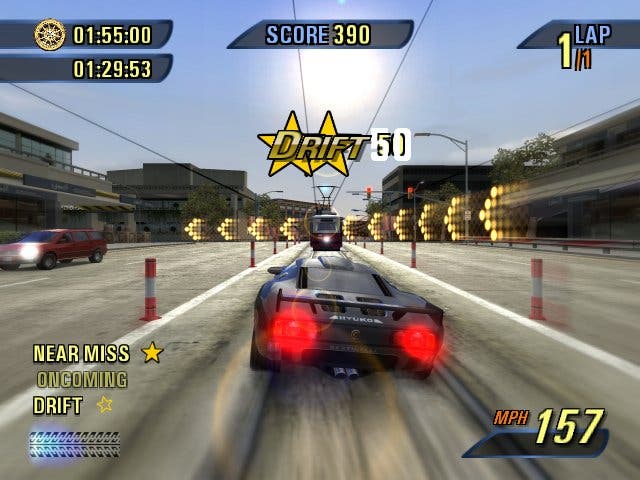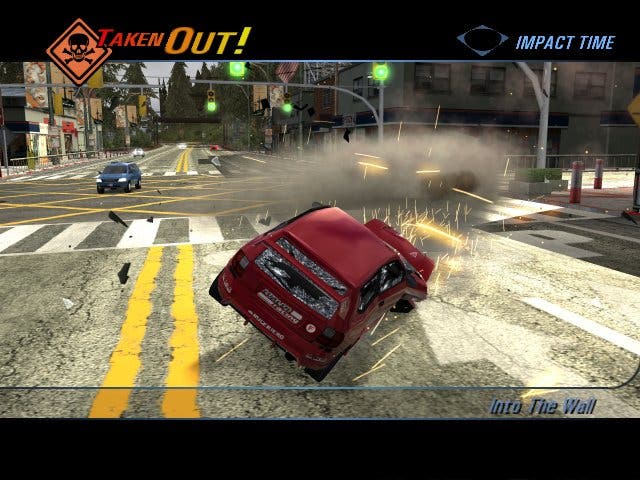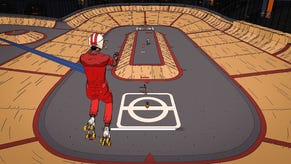Burnout 3: Takedown
Pure racing insanity.
It seems utter madness that a game of the quality of Burnout 2 wasn't a massive hit outside of Europe. Maybe it was Acclaim's ongoing inability to compete with the big guns in the US that was to blame, or maybe consumers weren't that convinced about the original and wrongly assumed the quick-fire sequel would be more of the same. They couldn't have been more wrong, and the fact that it still stands out as one of the best looking games and most addictive ever says a lot. Acclaim's loss was very much EA's gain, and if any games publisher in the world knows how to sell to the Yanks, it's EA. If Burnout 3 sells less than four times what its predecessor sold we'd be very surprised indeed.
Despite EA already having a best seller in the racing genre in Need For Speed Underground, it was a no-brainer for EA to sign Burnout 3. Criterion has, over the last three years, carved a category all of its own, featuring a crash-based all-action style of racing that no other game has come anywhere near to matching. The question that troubled hardcore followers of the series though was just how evident EA's paw prints would be on the game. Would it be diluted for the masses, or would the Brits hold out and stick to their guns?
Burnout: Tricky
The influence EA has had on Burnout 3's gestation cannot be underestimated, but rather than being forced it's a mutual appreciation. You can see it, hear it and feel it everywhere, but given Criterion's love for SSX it was undeniably a match made in heaven when EA jumped the queue and snapped up the rights to publish the game from under everyone else's noses. EA was so impressed it then bought the bloody company only a few months later in as canny a piece of games industry business as you'll ever see. Now not only does it have the world's best arcade racing developer, but the industry's leading middleware provider. All it needed was the game to match.

What did we expect from Burnout 3? More tracks, modes, cars, better graphics? Naturally. Online? Of course. Once EA inked that deal with Microsoft back at E3 we knew our Burnout 3 dreams were going to come true. We were fully excited, almost carried away with the idea of being able to translate the offline gameplay into six player racing, Party Crash and the rest. The only grey area was how long had Criterion been working on Live? Was it bolted on at the last minute? We'd been told in the past that there was definitelyno Live play. Not the ideal preparation for what, next to Halo 2 and PES 4, was the year's biggest Xbox Live offering. Nevertheless, how could anyone with access to PS2 or Xbox online gaming not feel a pang of excitement? The gameplay was so well suited to online multiplayer it would have been a heinous crime not to base the game around it.
But before we dive headlong into our online indulgence, it's important to acknowledge the fact that the vast majority of the people that buy this game will never play it online. Does that matter? Amazingly, no. For the thirty or so hours we were surgically attached to the TV playing this game, the vast majority of that was played offline on our own, unlocking all 100 crash junctions, attempting to battle through all 76 races and trying to scoop gold medals and headlines. It's an absolutely mammoth game, make no mistake.
What goes on tour stays on tour

Although there are the usual Single Event and Time Attack modes, World Tour is likely to be where you'll spend most of your time. Crash Junctions or Races are accessed via global Sat Nav that enables you to visit three continents (US, Europe, Asia) in an epic series that places equal weight on both disciplines. Unlike before, the excellent Crash Junctions are accessible from the off (previously, the PS2 version of B2 only made these available some way into the game), and in truth this has proven to be a masterstroke; we became so hooked on them we devoted more time to them than any other area of the game.
In pure single-player mode, Crash Junctions have been fleshed out to provide often quite lengthy sections, which you can approach in a number of different ways. The premise of causing the biggest pile-up possible remains your goal, but this time Criterion has thrown in a number of new features that add a tactical edge to the proceedings. Chief among them is the new Crashbreaker ability, which kicks in once you've clocked up a predetermined number of crashes, and allows you to effectively detonate your car and then steer it with mid-air aftertouch in the direction of your choice, either into the path of other oncoming vehicles or the other collectables lying around.
With a bit of luck and no small amount of skill you can often engineer situations whereby you can explode your car in the direction of previously unobtainable score multipliers, or possibly another explosion. On the downside, the game also places an evil score-halving Heartbreaker near to goodies, often reducing triumphant performances to a miserable total. In truth, such is Crash Junction's appeal, we'd gladly buy the game even if it consisted solely of this mode offline. Quite often we'd spend half an hour at a time solely attempting new ways to conquer a particular junction: to take the boost or not, which angle to take ramp at and so on - and on top of that it's a beautiful visual spectacle with stupendous use of slow motion, only slightly marred by the lack of a more spectacular replay, or the ability to switch camera angles during it.
In offline multiplayer it's possibly even more riotous, allowing for the genius two player co-op Team Crush where you have to work together to cause even more insanity and the versus Double Impact mode, while Party Crash allows up to eight players to take it in turns on any of the unlocked junctions.
Look out! Cliff!

Racing is just as much carnage as it ever was, and in fact has been ramped up to include six drivers in the race from the off, as opposed to the four of previous versions. Knowing full well that online play would be full of idiots driving the wrong way and trying to be annoying as they always tend to do in online racing games, Criterion struck upon the realisation that basing the entire racing mode on the concept of 'takedowns' would solve this annoyance.
Stuck for a 'language of crashes' Criterion has taken inspiration from Tony Hawks and SSX with each successful takedown given its own specific name, such as 'Wall Takedown' or 'Psyche Out', while each track gives opportunities to come up with your own Signature Takedown, for example sending your opponent down a cliff side or other unique, one-off spectaculars. Boost, as ever, is a key part of the proceedings, and can be gained from the usual dangerous manoeuvres that previous players will be well and truly familiar with, like driving into oncoming traffic.



